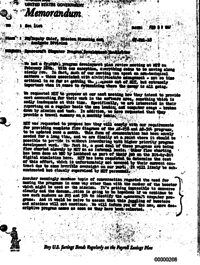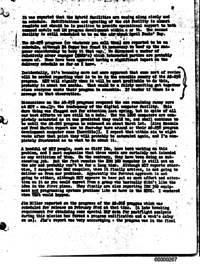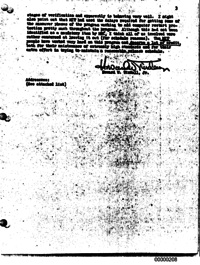Upthread: AS-206 Spacecraft Computer Program Newsletter (Jan 31, 1967)
Downthread: MIT’s digital computer facilities are still a problem (Apr 18, 1967)
See listFEB 27 196767-FM1-18FM/Deputy Chief, Mission Planning and Analysis DivisionSpacecraft Computer Program Development Newsletter
We had a fruitful program development plan review meeting at MIT on February 15th. With one exception, everything seems to be moving along nicely now. In fact, much of our meeting was spent on non-technical matters – those associated with administrative management – not so time critical in so far as getting the programs out of MIT, but extremely important when it comes to determining where the money is all going.
We requested MIT to propose at our next meeting how they intend to provide cost accounting for their work in the software area, something which is sadly inadequate at this time. Specifically, we are interested in their reporting on a regular basis the man loading and computer usage – broken down by mission and task. In addition, we have requested that they provide a travel summary on a monthly bases.
MIT was requested to propose how they will comply with our requirements for providing complete flow diagrams of the AS-258 and AS-504 programs, to be updated once a month. This form of documentation had been sorely needed for a long time, and we are finally at a point where it should be possible to provide it without interfering with higher priority program development work. The fact is, a good deal of these programs are being flow charted already by MIT on an informal bases. Other flow charting has been done at MSC by Lockheed as part of their job on the Bit-by-Bit digital simulation here. MIT has been requested to determine the cost of this effort, which is unfortunately not covered by their current con- tract due to some horrible oversight on our part. It will likely be sub- contracted but closely supervised by MIT personnel
Another seemingly mundane topic of conversation regarded the need for naming the programs in some way other than with the number of the booster which might be used on the mission. It's getting impossible to converse clearly and the documentation is going to be hopeless if we continue to use such numbers as 205 and 504 to identify the spacecraft computer pro- grams. And it would be naive to assume that this juggling of boosters and missions will not continue. We will inform you of the new, more des- criptive program names as soon as they have been selected.
It was reported that the Hybrid facilities are coming along nicely and on schedule. Modifications and uprating of the old facility is almost complete and should be in position to provide operational support to both command module and LM program development within a month. The second facility is still scheduled to be on the air about April Fools' Day.
The AS-278 programs (or whatever you call them) are reported to be on schedule, although Ed Copps has found it necessary to beef up the man- power considerably to keep it that way. We discussed a number of relatively minor changes (MDRB's) which interested parties are probably aware of. None have been approved having a significant impact on the delivery schedule as far as I know.
Incidentally, it's becoming more and more apparent that some sort of review will be needed regarding what is to be in the erasable memory of the AS-258 program. MIT will signify when it will be most profitable to do this, probably in about two months. That could be a fairly exciting get together since everyone wants their program in erasable. I wonder if there is a message in that observation.
Discussions on the AS-258 programs reopened the one remaining runny sore at MIT – namely, the inadequacy of the digital computer facility. This darn thing was flagged out for attention last spring, but in spite of all our best efforts we are still in a hole. The two 1800 computers are com- pletely saturated as it was predicted they would be, and shall continue to be until the AS-206 program is released on about March 1st. [Alex Kosmala and Freg Martin report one to four-day turn around on their AS-258 program development computer runs (horrible)]. I expect that within six to eight weeks after that point they will probably be saturated again, and I'm com- pletely frustrated as to what to do about it.
A handful of MIT people, such as Cliff Ido, have been working on this problem, and I must emphasize that these words are certainly not intended as any criticism of them. On the contrary, they have been doing an out- standing job. But the fact remains the IBM 360 computer is still not on the air and probably won't be for a long time. Although MIT reports other- wise, I suspect the MAC compiler, when it finally arrives, is not going to deliver us from our problems. Apparently the Fortran approach is not going to either, although MIT appears to have put as much effort and atten- tion on it as you could expect from a group who basically didn't like the idea in the first place. They finally are also reporting IBM 360 equip- ment and programming systems problems like we have in the RTCC. I wondered when that would happen.
Jim Miller reported on the progress of the AS-206 program which was scheduled for release on February 22nd at that time. [A late breaking requirement for obtaining some special DAP data for postflight analysis during this mission has forced a program modification and a week's delay on us]. Jim's report was very encouraging – the program was in the final stages of verification and apparently is behaving very well. I might also point out that MIT had used the delays required for getting some of the maneuver phases of the program working to add computer restart pro- tection pretty much throughout the program. Although this had not been identified as a mandatory item by MBC, I think all of us involved were rather concerned at leaving it out (for schedule reasons). The MIT people have worked very hard on this program and deserve a lot of credit, both for their maintenance of extremely high standards and for their extra effort in trying to maintain a reasonable release schedule.
- Dec 22, 1966 – MIT’s digital computers are saturated until the IBM 360 becomes operational (4.3σ)
- Apr 18, 1967 – MIT’s digital computer facilities are still a problem (4.2σ)
- Oct 18, 1967 – Spacecraft computer program development improvements to be utilized by MIT (3.7σ)
- Oct 10, 1966 – More on Program Development (3.1σ)



